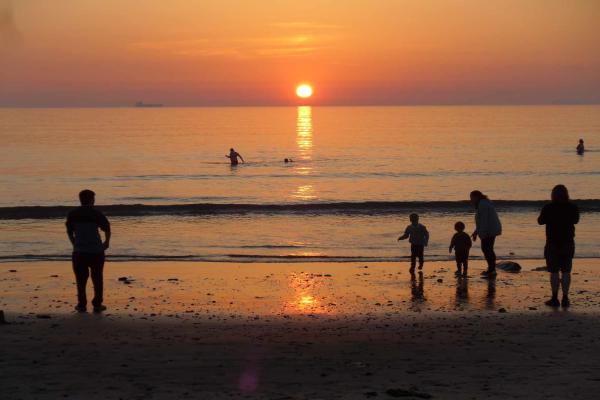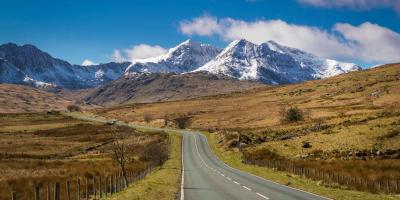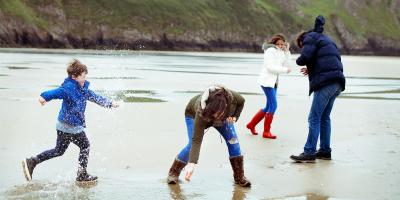Every day at breakfast the conversation turned to puffins and their chicks: pufflings. The birds had arrived early on Skomer Island this year because of the unusually warm weather. "The ground was literally carpeted with puffins" said one fellow-hosteller who'd done the boat trip the previous day. Another was hoping to return when the pufflings had hatched.
Like all hostel self-catering kitchens, the one at YHA Broad Haven in Pembrokeshire was a great place to learn about the best places to see local wildlife, and to swap notes — even impressions — with nature-lovers of all ages about what we'd seen and heard.
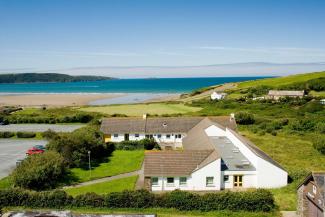
There was a charm of goldfinches in the hostel garden and a conspiracy of ravens in the nearby wood. On the beach, just 100 metres away, we heard the "peep peep peep" of oystercatchers and saw gannets wheeling high above, then braking, stretching their wings, and plunging decisively into the waves. A poster in the Londis shop on the promenade explained what to do should you find a stranded Manx shearwater (puffinus puffinus): they can find it hard to become airborne again if they crash land.
In the centre of Broad Haven village there is a wetland and woodland wildlife reserve called the Slash Pond, created from old open-cast coal workings. An initiative of the local community, the 275 metre boardwalk all around makes it accessible for wheelchairs and pushchairs, and it is a wonderful place to listen to the dawn chorus or watch bats at dusk. The streams have been dyed bright orange by naturally-occuring iron oxide.
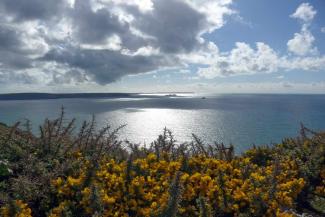
Up on the Pembrokeshire Coastal Path, which passes the hostel, we saw a handsome bird with a black head and orange breast hopping along the fence posts and eyeing us quizically. Not knowing what it was we asked the next passer-by who was sporting binoculars: it was a stone chat. Down on the beach, what I thought was a skylark turned out to be a rock pipit.
As well as bird-watching, visitors can explore rock pools full of hermit crabs, anemones, and whelk egg cases. There are some good ones at Little Haven beach, a short low-tide walk along the shore from Broad Haven and dominated by a huge arching cave called Fox Hole. The women sprinting out of the sea turned out to be heading for the tiny sauna, located right on the front in a shepherd's hut. In the RNLI shop we stocked up on biscuits and chutney; they also sell useful beach things such as rock-pooling nets. Haverfordwest Male Voice Choir was holding an RNLI benefit concert in the village hall.
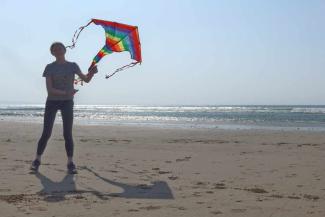
The windy expanse of Newgale Sands, eight miles north of Broad Haven, is impressive for its scale, emptiness, and rolling breakers; it's a favourite with surfers and body-boarders. We got out our kite and ran along the smooth, obstacle-free tideline to connect with the swirling gusts above; it swooped and climbed without us even trying.
Marloes Sands, eight miles south, is completely different because of its intriguing geological formations: layers of rock that have slid and been crushed into natural sculptures. After a cake-stop at the Runwayskiln cafe, up on the cliff, we walked around the anthill-dotted headland, from where we could see Skomer across the channel. Sadly we didn't see any puffins, but there were some magnificent choughs, a rare red-beaked and red-legged member of the corvid family, like crows dressed for the Met Gala. Other hostellers had seen adders: "Dim panic, dim niwed/Stay calm, no harm" said the signs in the car park.
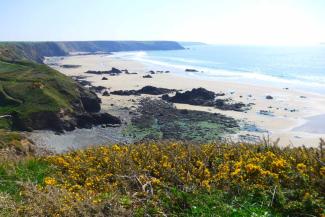
At Druidston Haven beach, the cliffs are striped and mottled with the kind of natural pigments that inspired cave-dwellers to make the earliest art. During our visit contemporary land artist Jon Foreman spent hours patiently drawing a big, elaborate flower in the wet sand, knowing it would be swept away by the next tide. Everyone in our family enjoyed the beach in a different way: my partner practised his long jump run up for an upcoming competition, our daughter offered seaweed treatments for tired limbs, and our son simply loved sinking his feet into the warm sandy bottoms of the rock pools and listening to the susurrations of the waves.
We walked to Druidston and back from Broad Haven, following a 4.7 mile circular walk developed for the YHA's annual Festival of Walking. The route traversed a wood full of celandines and frothy blackthorn blossom, and the spring song of willow warblers and chiff chaffs, which we identified with the help of the Merlin app. After visiting the beach we walked back along the coastal path: the silvery Irish Sea glittered beyond the coconut-scented gorse. There were oil beetles and celandines, bumble bees and violets that -- far from shrinking -- were thriving on the exposed clifftops.
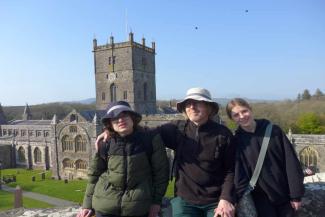
One day we took a trip to Britain's smallest city, St David's, where we admired its cathedral and Bishop's Palace. On another we visited Tenby, famous for its harbour, which was visited by a walrus during lockdown; its brightly-coloured Regency houses; and Robert Recorde, the sixteenth century mathematician who invented the "equals" sign. Is there any other town with so many benches where you can pause to enjoy the view? An innovative project by Tenby Museum and Art Gallery means that on some you can use a QR code to find out about the historical events you would have been able to see from that very spot. The museum's art collection includes works by Gwen John and Augustus John and there's an interesting film about two centuries of tourism. Castle Beach is lively and great for people-watching while gently-sloping South Beach stretches for two miles and is scattered with driftwood and shells.
Being west-facing, Broad Haven's own strand is a sunset beach. Each evening of our week-long stay the sun departed in a different way: one day it was improbably huge and pink, leaving the sky a wash of watercolour rose and gold; on another cumulonimbus clouds piled up, threatening rain, then were suddenly lit up by a last ray of light. Local people and visitors alike gathered to watch the spectacle. On the last day of term teenagers headed there to hang out after school while toddlers in wellies bravely defied the incoming tide. A women's rugby team practised passes and tackles and a romantic soul wearing a heart-patterned jumper ran out into the waves at the very last moment, curtseying to the sun as it dipped below the horizon.
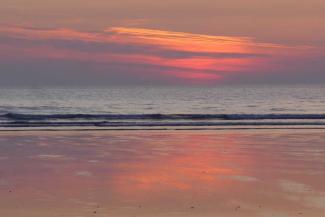
YHA Broad Haven was a comfortable and convenient place to stay. The garden and self-catering kitchen have views of the sea. The hostel has been playfully decorated with a maritime theme: there's a whale on the ceiling of the cafe; trompe l'oeil decorations such as starfish on the room doors; even the fire-extinguishers have been transformed into the oxygen tanks of divers.
On the way home we said "goodbye" to Wales by climbing the spectacular ramparts of Dinefwr Castle in Carmarthenshire, from where there were 360 degree views of the surrounding countryside, and the tree canopy breaking into lime-green leaf.
Please note: there are two Broad Havens in Pembrokeshire. The hostel is located at the one near Haverfordwest, not Broad Haven South. To make the beaches of Pembrokeshire more accessible to people with disabilities, the National Park has set up a beach wheelchairs scheme, and YHA Broad Haven is part of this.
Read more of Jenny’s blogs.
Discover more about YHA.
